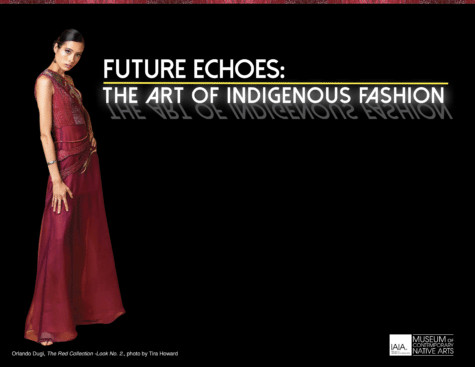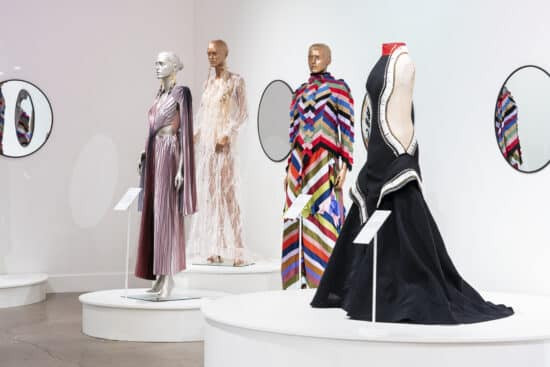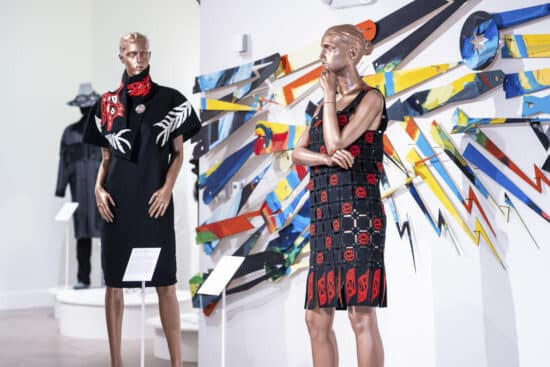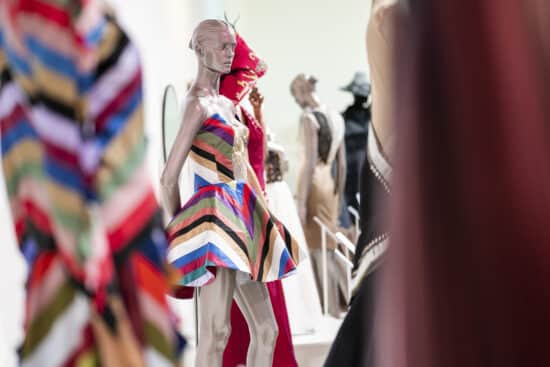Indigenous Fashion for men showcases a vibrant fusion of heritage and contemporary style, offering unique garments and accessories. At mens-fashion.net, we help you explore the latest trends and how to incorporate them into your wardrobe. Discover how to honor cultural roots while staying fashion-forward with indigenous designs and native-inspired clothing.
1. What Defines Indigenous Fashion and Its Significance?
Indigenous fashion is more than just clothing; it embodies the history, culture, and identity of native communities. It’s a powerful form of artistic expression and storytelling.
Indigenous fashion uses traditional techniques, materials, and motifs passed down through generations. According to the Fashion Institute of Technology (FIT), indigenous designs often incorporate natural dyes, handwoven textiles, and intricate beadwork that reflect a deep connection to the land and its resources. This fashion movement also addresses social issues, acting as a stage for cultural preservation and social activism. Designers frequently use their work to reclaim and redefine indigenous narratives, challenge stereotypes, and promote cultural pride.
2. What Are The Current Trends in Indigenous Menswear?
Modern indigenous menswear blends traditional aesthetics with contemporary styles. Expect to see a fusion of classic silhouettes and modern urban pieces.
2.1 Key Trends
- Textiles and Patterns: Traditional weaving techniques are reimagined in contemporary garments like jackets and shirts. Geometric patterns and tribal motifs are prominent, often screen-printed or embroidered onto modern fabrics.
- Silhouettes: Designers are blending classic menswear silhouettes with indigenous elements. Think tailored jackets with tribal-inspired embroidery, or modern shirts featuring traditional weaving patterns.
- Accessories: Accessories play a vital role in completing the look. Beaded jewelry, handcrafted leather goods, and traditionally woven scarves add an authentic touch.
- Color Palettes: Earth tones like browns, greens, and blues are common, alongside vibrant hues inspired by nature and traditional dyes.
- Materials: Natural and sustainable materials, such as organic cotton, hemp, and locally sourced wool, are increasingly favored.
- Modern Adaptations of Traditional Garments: Traditional garments such as ribbon shirts are reimagined with contemporary cuts and fabrics, making them more accessible for everyday wear.
2.2 Examples of Indigenous Menswear Trends
| Trend | Description |
|---|---|
| Tribal Print Bomber | A modern bomber jacket featuring bold tribal prints. |
| Woven Panel Shirt | A contemporary shirt with woven panels showcasing traditional patterns. |
| Beaded Leather Bracelet | A handcrafted leather bracelet adorned with intricate beadwork. |
| Earth-Tone Layering | An ensemble that layers earth-tone garments for a natural and stylish look. |
| Ribbon Shirt Update | A modern version of the ribbon shirt, tailored with contemporary fabrics and cuts. |




3. How Can Men Incorporate Indigenous Fashion Into Their Wardrobe?
Adding indigenous-inspired pieces to your wardrobe can be a stylish and respectful way to celebrate native cultures. Start with subtle accents and build from there.
3.1 Tips for Integrating Indigenous Fashion
- Start Small: Begin with accessories like beaded bracelets, woven belts, or scarves with tribal patterns.
- Focus on Quality: Look for pieces made with authentic materials and craftsmanship. This ensures longevity and respects the artistry behind the design.
- Mix and Match: Pair indigenous-inspired pieces with your existing wardrobe. For example, wear a tribal-print shirt with jeans or chinos.
- Support Indigenous Designers: Seek out and support native designers. This helps sustain their craft and ensures fair compensation.
- Respect the Culture: Educate yourself about the cultural significance of the designs you wear. Avoid appropriating sacred symbols or patterns without understanding their meaning.
3.2 Styling Ideas
- Casual Look: Combine a tribal-print t-shirt with dark wash jeans and sneakers. Add a beaded bracelet for a touch of authenticity.
- Business Casual: Wear a tailored jacket with subtle indigenous embroidery over a solid-colored shirt and dress pants. Finish with leather loafers.
- Outdoor Adventure: Pair a woven vest with a long-sleeve shirt, hiking pants, and boots. Accessorize with a traditional woven scarf.
4. Who Are Some Prominent Indigenous Fashion Designers?
Supporting indigenous designers is crucial for promoting cultural preservation and economic empowerment.
4.1 Featured Designers
- Lloyd Kiva New (Cherokee): A pioneer in Native American fashion, known for his innovative designs and use of traditional motifs.
- Patricia Michaels (Taos Pueblo): Renowned for her avant-garde designs that blend traditional techniques with modern silhouettes.
- Dorothy Grant (Haida): Celebrated for her elegant and sophisticated garments that incorporate Haida art and symbolism.
- Jamie Okuma (Luiseño): Known for her intricate beadwork and contemporary designs that reflect her cultural heritage.
- Orlando Dugi (Diné): A textile artist and fashion designer who creates luxurious, handwoven garments.
4.2 Designers’ Impact
These designers significantly contribute to the fashion industry by:
- Preserving Cultural Heritage: Showcasing traditional techniques and motifs in contemporary designs.
- Promoting Cultural Pride: Empowering indigenous communities through fashion and art.
- Challenging Stereotypes: Redefining perceptions of indigenous fashion and culture.
- Fostering Economic Growth: Creating sustainable businesses and employment opportunities within native communities.
5. Where Can You Find Indigenous Fashion Brands and Retailers?
Discovering authentic indigenous fashion brands and retailers supports native artisans and ensures you’re purchasing ethically made products.
5.1 Recommended Retailers
- Etsy: Features numerous indigenous artisans and small businesses selling handcrafted clothing and accessories.
- Beyond Buckskin Boutique: An online retailer dedicated to showcasing and selling indigenous-designed fashion and accessories.
- NATIC: A platform that promotes Native American-owned businesses, including fashion brands.
- Eighth Generation: A Seattle-based company owned by the Snoqualmie Tribe, offering a range of indigenous-designed products.
- Local Native Art Markets: Attending local native art markets and powwows provides an opportunity to meet designers and purchase directly from them.
5.2 Shopping Tips
- Research the Brand: Before purchasing, research the brand to ensure they are genuinely indigenous-owned and committed to ethical practices.
- Read Reviews: Check customer reviews to gauge the quality of the products and the reputation of the retailer.
- Ask Questions: Don’t hesitate to ask questions about the materials, techniques, and cultural significance of the designs.
- Support Fair Trade: Look for brands that adhere to fair trade practices and provide fair compensation to their artisans.
- Verify Authenticity: Ensure that the products are genuinely handmade and not mass-produced imitations.
6. What Is The Role of Cultural Appropriation in Indigenous Fashion?
Cultural appropriation is a sensitive issue in indigenous fashion. Understanding the difference between appreciation and appropriation is crucial for respecting native cultures.
6.1 Understanding the Difference
- Cultural Appropriation: Occurs when elements of a minority culture are taken and used by members of the dominant culture without permission, understanding, or respect. This often involves trivializing sacred symbols, perpetuating stereotypes, and profiting from cultural heritage without compensating the original creators.
- Cultural Appreciation: Involves learning about, respecting, and supporting a culture in an informed and ethical manner. This includes purchasing directly from indigenous artisans, acknowledging the cultural significance of designs, and avoiding the commercialization of sacred symbols.
6.2 Avoiding Appropriation
- Educate Yourself: Learn about the history, culture, and significance of the designs you are interested in.
- Seek Permission: If you are inspired by a specific design, seek permission from the artist or community before incorporating it into your own work.
- Credit the Source: Always credit the indigenous culture or artist that inspired your design.
- Support Indigenous Artists: Purchase directly from indigenous artists and businesses to ensure they are fairly compensated for their work.
- Avoid Stereotypes: Be mindful of perpetuating stereotypes or trivializing sacred symbols.
7. How Does Indigenous Fashion Contribute to Sustainability?
Indigenous fashion often embraces sustainable practices, making it an eco-conscious choice for the environmentally aware consumer.
7.1 Sustainable Practices
- Natural Materials: Indigenous designers frequently use natural, locally sourced materials such as organic cotton, hemp, wool, and natural dyes.
- Traditional Techniques: Handwoven textiles, natural dyes, and intricate beadwork are environmentally friendly alternatives to mass-produced garments.
- Waste Reduction: Many indigenous artisans utilize traditional techniques that minimize waste, such as using every part of an animal hide or plant.
- Ethical Production: Indigenous fashion often emphasizes ethical production practices, ensuring fair labor standards and safe working conditions.
7.2 Benefits of Sustainable Fashion
- Reduced Environmental Impact: Natural materials and eco-friendly processes minimize pollution and conserve resources.
- Support for Local Economies: Purchasing indigenous-made garments supports local artisans and communities.
- Healthier Products: Natural dyes and materials are often free from harmful chemicals, making them safer for consumers.
- Durable and Long-Lasting: Handcrafted garments are often more durable and long-lasting than mass-produced items, reducing the need for frequent replacements.
8. What Are The Cultural and Historical Influences on Indigenous Fashion?
Understanding the cultural and historical context of indigenous fashion provides a deeper appreciation for its artistry and significance.
8.1 Historical Influences
- Pre-Columbian Era: Indigenous cultures across the Americas developed unique clothing styles and adornments using natural materials and traditional techniques.
- Colonial Period: The arrival of European colonizers led to the suppression of indigenous cultures and the imposition of Western clothing styles.
- Cultural Revitalization: In recent decades, there has been a resurgence of interest in indigenous cultures, leading to a revival of traditional arts and crafts, including fashion.
8.2 Cultural Elements
- Tribal Symbols: Indigenous designs often incorporate tribal symbols, such as animals, plants, and geometric patterns, which hold deep cultural significance.
- Spiritual Beliefs: Many indigenous garments are imbued with spiritual meaning and are worn for ceremonies and rituals.
- Social Status: Clothing and adornments often indicate social status, clan affiliation, and personal achievements within indigenous communities.
9. How Is Indigenous Fashion Represented in Mainstream Media?
The representation of indigenous fashion in mainstream media plays a crucial role in shaping perceptions and promoting cultural understanding.
9.1 Media Portrayals
- Fashion Magazines: Highlighting indigenous designers and models in fashion editorials helps to increase visibility and challenge stereotypes.
- Runway Shows: Showcasing indigenous fashion at major fashion weeks provides a platform for designers to reach a wider audience.
- Documentaries: Documentaries that explore the history, culture, and artistry of indigenous fashion can promote cultural understanding and appreciation.
- Social Media: Social media platforms provide a space for indigenous designers and influencers to share their work and connect with audiences.
9.2 Improving Representation
- Diverse Representation: Ensuring that indigenous models, designers, and voices are represented in mainstream media.
- Accurate Portrayals: Avoiding stereotypes and providing accurate and respectful portrayals of indigenous cultures.
- Supporting Indigenous Voices: Giving indigenous designers and artists the opportunity to tell their own stories and share their perspectives.
10. What Events and Exhibitions Showcase Indigenous Fashion?
Attending events and exhibitions that showcase indigenous fashion provides an opportunity to experience the artistry and cultural richness of native designs.
10.1 Notable Events
- Santa Fe Indian Market: An annual event in Santa Fe, New Mexico, featuring a wide range of indigenous art, including fashion.
- Southwestern Association for Indian Arts (SWAIA) Fashion Show: A fashion show held during the Santa Fe Indian Market, showcasing the latest indigenous designs.
- Indigenous Fashion Week Toronto (IFWTO): A biennial event in Toronto, Canada, dedicated to showcasing indigenous fashion from around the world.
- Museum Exhibitions: Many museums across the United States and Canada host exhibitions that feature indigenous art and fashion.
10.2 Benefits of Attending
- Experiencing Artistry: Witnessing the craftsmanship and artistry of indigenous fashion firsthand.
- Supporting Designers: Purchasing directly from designers and supporting their work.
- Learning About Culture: Gaining a deeper understanding of the cultural significance of indigenous designs.
- Networking: Connecting with designers, artists, and other enthusiasts in the indigenous fashion community.
Incorporating indigenous fashion into your wardrobe is more than just a style choice; it’s a way to honor and celebrate the rich cultural heritage of native communities. Remember to approach it with respect, support indigenous designers, and educate yourself about the significance of the designs you wear.
Ready to explore more about indigenous fashion and find the perfect pieces to express your style? Visit mens-fashion.net today to discover the latest trends, designer profiles, and styling tips. Our comprehensive guides will help you incorporate indigenous-inspired elements into your wardrobe with confidence and cultural sensitivity. Connect with us at 227 W 27th St, New York, NY 10001, United States, or call us at +1 (212) 217-5800.
FAQ About Indigenous Fashion
1. What is indigenous fashion?
Indigenous fashion embodies the history, culture, and identity of native communities through traditional techniques, materials, and motifs.
2. How can I respectfully incorporate indigenous fashion into my wardrobe?
Start with accessories, focus on quality, mix and match pieces, and support indigenous designers while respecting the culture.
3. Who are some well-known indigenous fashion designers?
Notable designers include Lloyd Kiva New (Cherokee), Patricia Michaels (Taos Pueblo), and Dorothy Grant (Haida).
4. Where can I find authentic indigenous fashion brands?
Look for brands on Etsy, Beyond Buckskin Boutique, NATIC, and Eighth Generation, or attend local native art markets.
5. What is cultural appropriation, and how can I avoid it?
Cultural appropriation is taking elements of a culture without permission or respect. Avoid it by educating yourself, seeking permission, and supporting indigenous artists.
6. How does indigenous fashion contribute to sustainability?
It often embraces natural materials, traditional techniques, waste reduction, and ethical production practices.
7. What are the historical influences on indigenous fashion?
Influences include the Pre-Columbian era, the colonial period, and the cultural revitalization movement.
8. How is indigenous fashion represented in mainstream media?
It is portrayed in fashion magazines, runway shows, documentaries, and social media, with a need for diverse and accurate representation.
9. What events showcase indigenous fashion?
Events include the Santa Fe Indian Market, IFWTO, and museum exhibitions.
10. Why is it important to support indigenous fashion designers?
Supporting them helps preserve cultural heritage, promote cultural pride, challenge stereotypes, and foster economic growth in native communities.